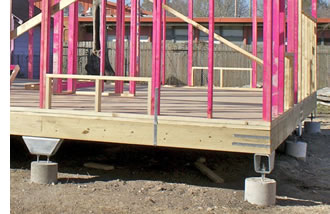

Webmaster: Stansfeld, LLC. |
|
|

DECEMBER 2009 MEETING
Wednesday, December 9, 2009
TECHNICAL
PROGRAM
Contrasting Design Approaches For Slabs-On-Ground And Raised Floor Foundations On Expansive Soils
Speaker: Professor Robert L. Lytton, Ph.D., P.E., of Texas A&M University, Bryan TX, Tel. No. 979-845-9964
Dr. Lytton is an Honorary FPA Life Member, Professor of Civil Engineering in the Zachry Civil Engineering Department of the Texas A&M University and a Licensed Professional Engineer that has earned his degrees, including his Ph.D. in Civil Engineering, from the University of Texas.
Bruce Cordova , of APA The Engineered Wood Association, Houston TX, Tel. 281-463-0742, briefed the audience on the costs of raised floor foundations at the end of Dr. Lytton's presentation. Mr. Cordova, earned his BSCE from TAMU in 1972 and his MSCE from UH in 1979.
PRESENTATION SUMMARY
To an audience of about 90 at the HESS Club, Dr. Lytton presented "Contrasting Design Approaches For Slabs-On-Ground And Raised Floor Foundations On Expansive Soils". Dr. Lytton provided new technical data on the differences between the design of Raised Floor Foundations and Slabs on Grade. Near the close of his presentation, Dr. Lytton invited Bruce Cordova to briefly address the practical aspects of contrasting costs and construction methods of Raised Floor Foundations versus Slabs on Grade.
Dr. Lytton said his team at Texas A&M used the mechanistic-empirical approach in developing their data. He noted the two worst types of movement for Slabs on Grade were accounted for in the data by Edge Drying, due to trees, and Edge Wetting, due to over watering or poor drainage. He noted the worst type of movement for Raised Floor Foundations were accounted for in the data by moisture evaporation due to soil exposure below the center area of the foundation. According to Dr. Lytton, these two contrasting types of soil moisture changes dramatically affect the design approach that must be used when designing each of the two different types of foundations.
Dr. Lytton pointed out that a slab on grade foundation tends to protect the interior soils below the center of the slab from dramatic and short term moisture changes and therefore maintains a more uniform soil moisture content below the center of the slab. For slabs on grade the most dramatic soil changes and therefore the area of major concern during the design process are the stresses placed on the outer perimeter of the slab. In contrast, a raised floor foundation is open to the air and is not typically protected against dramatic moisture changes.
Dr. Lytton stated that most of their findings indicated that the area of concern for the design of raised floor foundation is loss of moisture below the central area of the slab resulting in edge lift. He also pointed out that raised floor foundation construction methods may lead to shallower supports and therefore some movement should be expected. Dr. Lytton presented a variety of design and construction methods for Raised Floor Foundations, several of which included adjustable supports that may permit ongoing slab leveling as soil conditions change.
Some points made by Dr. Lytton were:
- The moisture active zone is dictated by site conditions, not regional conditions.
- The moisture active zone can vary from say 3 to 20 feet when a tree is present.
- The geotechnical engineer should always log the root fibers since the depth of the shrinkage cracks are created by roots.
- The depth of the moisture active zone depends on the depth of the crack zone.
- The depth of the movement active zone, needed to compute Ym, will always be less than the depth of the moisture active zone.
- To account for homeowner watering, the foundation design engineer needs to use a suction range of 2.0 pF for slab on grade foundations and 3.0 pF for raised floor foundations.
- Irregular foundations with large shape factors (SF > 24) will be a limiting factor in slab on grade designs but not for raised floor designs.
- Soil movement does not form a uniform pressure on foundations.
- Using raised floor foundations introduces new design problems such as rotation and lateral pressures on the piers, due to more soil swelling occurring around the perimeter piers as opposed to more shrinkage occurring around the interior piers.
- In slab on grade designs, PTI's Edge Moisture distance (Em) varies from say 3 to 9 feet and is not a design cantilever distance as used in the BRAB and WRI design methods.
- Downhill creep is a concern for raised floor foundations. Creep can occur in slopes greater that 10 percent, particularly in wetter soils.
Mr. Cordova pointed out advantages of raised floor foundation, including less risk of flooding, easier below-floor maintenance of plumbing, etc., and easier foundation lifting. He believed that raised wood floor foundations can compare in cost to slab on grade foundations when using $6.60 - $7.50 / SF unit costs for the concrete slab on grade option. However there can be other requirements in raised floor foundations that raise its cost such as floor insulation, climate control of the crawl space, and the use of a moisture barrier to seal off the ground and perimeter walls.
To download Dr. Lytton's slide presentation,click here
To read summaries of previous FPA presentations by Dr. Lytton, please click:
December 2008
December 2007
December 2006
December 2004
August 2003
August 2002
August 2001
To download Mr. Cordova's slide presentation, click here
To read a summary of the previous FPA presentation by Mr. Cordova, please click here:
August 2008
|



